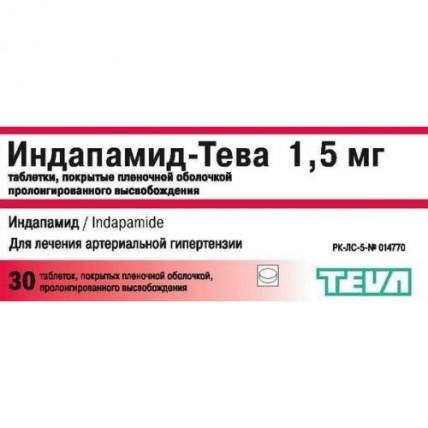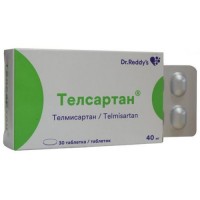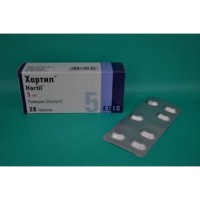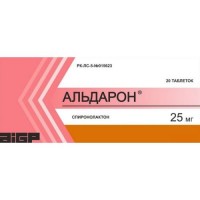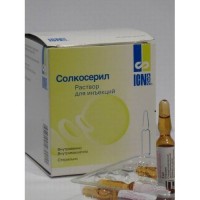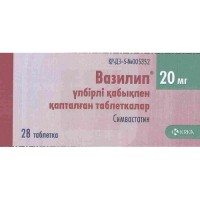Indapamide-Teva 1.5 mg film coated (30 tablets)
- $5.00
The instruction for medical use of medicine of Indapamid-Tev of 1.5 mg the Trade name of Indapamid-Tev of 1.5 mg the International unlicensed name Indapamid Lekarstvennaya the Tablet form, film coated, the prolonged release, 1.5 mg One tablet contains Structure: active agent - indapamid 1.50 mg, excipients: lactoses monohydrate, gipromelloza, silicon dioxide colloidal anhydrous, magnesium stearate, structure of a cover: a gipromelloza, glycerin, the titan dioxide (E171) the Description Round biconvex tablets, film coated from white till almost white color. Pharmacotherapeutic group Diuretics. Not thiazide diuretics operating on a cortical segment of a Henle's loop. Sulfonamides. Indapamid. The ATX C03BA11 code Pharmacological action Pharmacokinetics Indapamid of 1.5 mg is in the matrix providing gradual release of an indapamid. The released fraction of an indapamid is quickly and completely soaked up from digestive tract. Meal does not influence amount of the absorbed medicine. The maximum concentration in blood serum is reached in 12 hours after intake of a single dose. At repeated methods of fluctuation of concentration of drug between receptions decreases. Linking with proteins of plasma makes 79%. Elimination half-life makes from 14 to 24 hours (on average 18 hours). The equilibrium state is established in 7 days. Repeated use of an indapamid does not lead to accumulation. Indapamid is brought in the form of inactive metabolites generally with urine (70%) and excrements (22%). At patients with a renal failure the pharmacokinetic parameters do not change. Indapamid-Tev's pharmacodynamics of 1.5 mg is derivative sulfonamide with an indolovy ring. On pharmacological properties indapamid it is close to thiazide diuretics which mechanism of action consists in suppression of a reabsorption of sodium in a cortical segment of nephron. Indapamid increases discharge with urine of sodium, chlorine and to a lesser extent - potassium and magnesium that leads to increase in a diuresis and antihypertensive effect. Hypotensive action of an indapamid is also connected with improvement of elasticity of walls of arteries and reduction of the general peripheric resistance of vessels. Indapamid promotes reduction of a hypertrophy of a left ventricle of heart. At monotherapy of Indapamidy 1.5 mg of the prolonged release the hypotensive effect proceeds 24 hours, at the same time the moderate diuresis is observed. Indapamid does not influence lipidic (triglycerides, LPNP, LPVP) and carbohydrate metabolism, including at patients with diabetes with arterial hypertension. Indications - arterial hypertension accept the Route of administration and Indapamid-Tev's doses of 1.5 mg of the prolonged release on 1 tablet a day, in the morning, without chewing, washing down with enough water. The maximum daily dose – 1 tablet. If treatment is inefficient, the dose of drug is not recommended to be raised because of increase in risk of side effects without strengthening of hypotensive effect. In this case it is recommended to include other antihypertensive drug which is not diuretic in the scheme. A course of treatment individual according to the recommendation of the doctor. Side effects Very often (& gt, 1/10), it is frequent (& gt, 1/100, & lt, 1/10), infrequently (& gt, 1/1000, & lt, 1/100), is rare (& gt, 1/10000, & lt, 1/1000), is very rare (& gt, 1/10000), frequency is not established (on the basis of the available data it is not possible to carry out the development frequency assessment). Often - reactions of hypersensitivity - makulo-papular rashes Infrequently - vomiting Seldom - vertigo, fatigue, a headache, paresthesias - nausea, a constipation, dryness in a mouth It is very rare - arrhythmia, hypotension - pancreatitis - an abnormal liver function - a renal failure - a Quincke's disease, a small tortoiseshell, a toxic epidermal necrolysis, Stephens-Johnson's syndrome - an agranulocytosis, aplastic anemia, hemolytic anemia, a leukopenia, thrombocytopenia - the hypercalcemia Frequency is not established - a syncope - shortsightedness, the obscured sight, visual disturbances - development of hepatic encephalopathy in case of a liver failure, hepatitis, increase in level of liver enzymes - possible deterioration in a course of the existing sharp disseminate lupus erythematosus - the increased photosensitivity - a considerable hypopotassemia, especially at patients with high risk (see. Special instructions) - a hyponatremia increase in level of sugar, uric acid - lengthening of an interval of QT on the ECG, Bouveret's ventricular disease like Contraindication pirouette hypersensitivity to an indapamid, sulfonamide or one of drug components a heavy renal failure hepatic encephalopathy or the profound abnormal liver functions a hypopotassemia - the rare hereditary diseases connected with a lactose intolerance, deficiency of lactase or disturbance of absorption of glucose galactose - pregnancy and the period of a lactation - children's age up to 18 years Medicinal interaction not recommended combinations: Lithium: increase in concentration of lithium in blood and development of symptoms of overdose and also at a saltless diet (decrease in removal of lithium with urine). In need of purpose of such combination it is necessary to control carefully lithium level in blood plasma and to adjust a dose of diuretics. The combinations demanding precautions at use: Risk of developing arrhythmia like pirouette (in the conditions of a hypopotassemia). - antiarrhytmic drugs of the class Ia (quinidine, hydroquinidine, Disopyramidum), - antiarrhytmic drugs of class III (Amiodaronum, sotalol, dofetilid, ibutilid), - some antipsychotic drugs: fenotiazina (Chlorpromazinum, tsiamemazin, levomepromazinum, thioridazine, triftoperazin), benzamides (amisulpirid, Sulpiridum, sultoprid, tiaprid), phenyl propyl ketones (Droperidolum, haloperidol), other drugs: bepridit, tsizaprid, difemanit, erythromycin intravenously, galofantrin, mizolastin, pentamidine, sparfloksatsin, moxifloxacin, Vincaminum IV of the Combination of these drugs increase risk of developing ventricular arrhythmia, in particular Bouveret's ventricular disease like pirouette (the hypopotassemia contributes to the development of this effect) in this connection constant control of level of electrolytes, timely correction if necessary and monitoring of the ECG is necessary. Non-steroidal anti-inflammatory drugs (for system use), including selection inhibitors of cyclooxygenase-2 (TsOG-2) and salicylic acid in high doses (& gt, 3 g/days): Reduction of antihypertensive effect of an indapamid is possible. Risk of developing an acute renal failure at the dehydrated patients (owing to sharp decrease in glomerular filtration). From an initiation of treatment it is necessary to watch functional activity of kidneys and, if necessary, to provide sufficient hydration of an organism. Inhibitors of angiotensin-converting enzyme (APF). In the presence of a hyponatremia (especially at patients with a renal artery stenosis) co-administration of an indapamid and APF inhibitors increases risk of developing the profound hypotension and/or acute renal failure. In case of development of hypertensia as a result of the hyponatremia which developed after reception of an indapamid it is necessary: - to stop reception of an indapamid in 3 days prior to prescribing of APF inhibitors, resuming, if necessary, intake of kaliysberegayushchy diuretic, - or intake of APF inhibitor is begun with a small dose, gradually raising it. In the presence at the patient of cardiovascular insufficiency the intake of APF inhibitors is recommended to be begun with very small dose after a dose decline of the accepted kaliysberegayushchy diuretic. In all cases it is necessary to control function of kidneys (plasma creatinine) within the first weeks of treatment with APF inhibitors. At the simultaneous use of an indapamid and drugs reducing potassium level (Amphotericinum B intravenously, glyuko- and mineralokortikoida at system use, tetrakozaktid, the stimulating depletive) risk of development of a hypopotassemia (additive effect) increases. It is necessary to control potassium concentration and, if necessary, to adjust it. In need of prescribing of depletive it is necessary to use drugs without promoting effect on motility of intestines. Baclofenum enhances expressiveness of hypotensive effect of an indapamid (it is necessary to control a functional condition of kidneys and to adjust water balance). At joint appointment indapamidad with drugs of a digitalis it is necessary to consider that the hypopotassemia can strengthen toxic effect of cardiac glycosides. It is necessary to control the level of potassium and the ECG and, if necessary, to adjust therapy. Combinations which have to be taken into account Kaliysberegayushchy diuretics (for example, Spironolactonum, Triamterenum or amiloride) in a combination with indapamidy can lead to a hypopotassemia (especially at patients with a renal failure or diabetes) or hyperpotassemias. If the accompanying use is shown, drugs have to be used with extra care and with frequent monitoring of content of potassium in serum and the ECG. In the functional renal failure caused by action of an indapamid intake of metformin increases risk of developing lactic acidosis. It is not necessary to use metformin if the level of serumal creatinine exceeds 15mg/l (135 µmol/l) at men and 12mg/l (110 µmol/l) - at women. In the considerable dehydration of an organism caused by intake of diuretic drugs the risk of developing a renal failure against the background of use of iodinated contrast agents in high doses increases. Before use of iodinated contrast agents it is necessary to carry out rehydration. At simultaneous use of an indapamid with Imipraminum-like antidepressants, neuroleptics owing to mutual strengthening of hypotensive effect the risk of developing orthostatic hypotension increases. At simultaneous use with salts of calcium the increase in content of calcium in blood plasma as a result of decrease in its excretion with urine is possible. At use of an indapamid against the background of cyclosporine and a takrolimus the creatinine level in plasma even increases at the normal state of water and electrolytic balance. Corticosteroids and tetrakozaktid at system use reduce hypotensive action of an indapamid at the expense of a delay of water and sodium. Special instructions At the available abnormal liver function thiazide and tiazidopodobny diuretics can increase risk of developing hepatic encephalopathy. In such cases the intake of diuretic drugs is stopped. Cases of the increased photosensitivity at intake of thiazide and tiazidopobny diuretics are noted. During treatment it is recommended to protect skin from influence of solar and artificial ultraviolet rays. If during treatment the increased photosensitivity is noted, then administration of drug is recommended to be stopped. It is necessary to control carefully the level of sodium and potassium in blood, especially at elderly patients, patients with cirrhosis, coronary heart disease, heart failure, the exhausted patients and/or the taking several drugs at the same time. The hypopotassemia (& lt, 3.4 mmol/l), especially at the available lengthening of an interval of QT and bradycardia, can lead to development of disturbances of a warm rhythm like pirouette. At the low level of potassium the drug dose adjustment is required. Intake of thiazide and tiazidopodobny diuretics can lead to decrease in excretion of calcium with urine and to development of a hypercalcemia (it is necessary to differentiate with a hyperparathyreosis). At patients with diabetes it is regularly necessary to carry out monitoring of level of glucose to blood, especially in the presence of a hypopotassemia. At patients with the increased content of urates in blood the development of gout or increase of attacks at the available gout is possible. Therapeutic influence of thiazide and tiazidopodobny diuretics is most effective at normal function of kidneys or with small deviations (clearance of creatinine & lt, 25 mg/l or 220 µmol/l for adults). At elderly patients the level of creatinine has to be established taking into account age, weight and a floor. The hypovolemia caused by loss of water and sodium, arising at the beginning of administration of drug leads to decrease in glomerular filtration and increase in content of urea and creatinine in blood plasma that can aggravate the available renal failure. Active agent of drug of Indapamid-Tev of 1.5 mg can affect results of doping tests. Pregnancy and the period of a lactation It is necessary to avoid use of diuretics at pregnancy, including for removal of physiological hypostases. Diuretics can cause fetoplacental insufficiency with risk of a growth disorder of a fruit. Indapamid is allocated with breast milk therefore he is not recommended in the period of a lactation. The feature of influence of medicine on ability to run motor transport and potentially dangerous mechanisms Should be careful during the driving of motor transport and work with potentially dangerous mechanisms in connection with possible development of the individual reactions connected with decrease in the ABP, especially at the initial stage of treatment or at combination therapy with hypotensive drugs. The overdose Indapamid in high doses (40 mg, in 27 times more of a therapeutic dose) has no toxic effect. Symptoms: disturbances of water and electrolytic balance (hyponatremia, a hypopotassemia), nausea, vomiting, hypotension, spasms, vertigo, the drowsiness, confusion, a polyuria passing into an oliguria or an anury (owing to a hypovolemia). Treatment: gastric lavage and/or prescribing of activated carbon with the subsequent recovery of water/electrolytic balance. Symptomatic therapy. A release form On 10 tablets place in blister strip packagings from a film of polyvinylchloride and aluminum foil. On 3 planimetric packs together with the instruction for medical use in the state and Russian languages put in a pack cardboard Storage conditions to Store at a temperature not above 25 °C. To store out of children's reach! 3 years not to apply a period of storage after an expiration date. Prescription status According to the prescription Merkle GmbH Producer, Germany the Owner of the registration certificate ratiofarm GmbH, Germany
to Develop
to Develop
